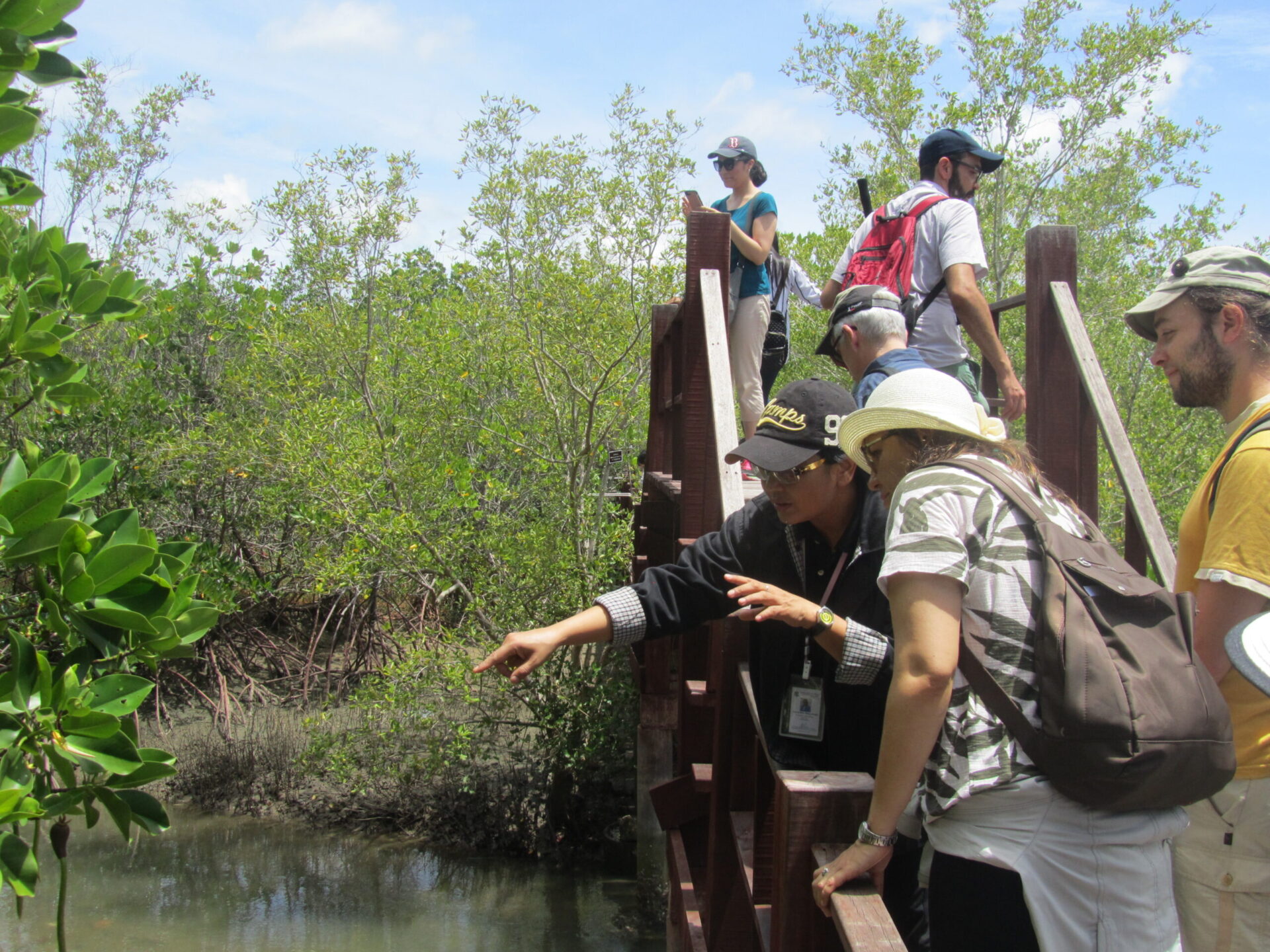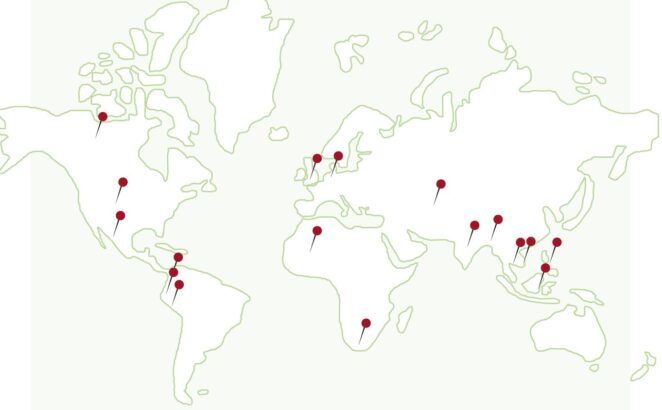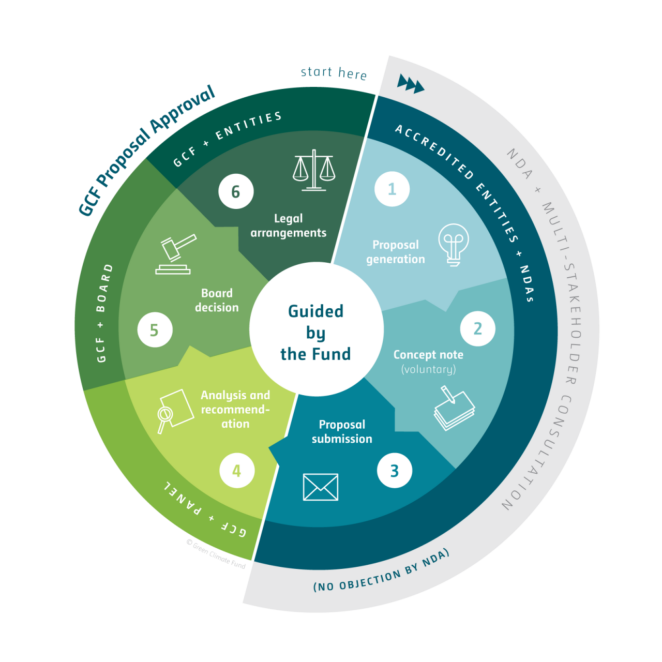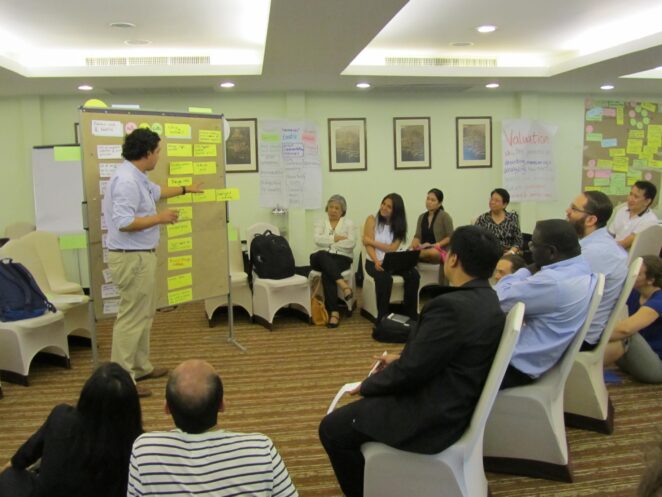Four Thematic Learning Briefs of the International EbA Community of Practice

Introduction
Currently, strengthening EbA in planning and decision-making faces several challenges. These include finding suitable mainstreaming entry points, financing options and instruments, monitoring and evaluation systems, and the generation of evidence on the effectiveness of EbA.
The international EbA Community of Practice, a knowledge and exchange network of EbA practitioners, government representatives, researchers and policy advisors facilitated by GIZ, shared their experiences on these topics during the 2nd international EbA Community of Practice Workshop that was conducted between 21 and 24 August 2017 in Bangkok, Thailand. The results of the learning and dialogue workshop were summarized in four Learning Briefs:
- What are experiences in mainstreaming Ecosystem-based Adaptation (EbA) into national and subnational policy processes?
- How to generate evidence on effectiveness and what are success stories on communicating EbA to a wider audience?
- What experiences on sources and instruments for financing EbA measures in different contexts does the international EbA Community of Practice have?
- And how to set up monitoring and evaluation (M&E) systems and indicators to track adaption results?

Key messages of the Learning Briefs
The following key messages have been identified. The findings are addressed in detail in each of the respective documents, available here.
Entry points for mainstreaming Ecosystem-based Adaptation are windows of opportunity – e.g. situations or processes – that help gain the interest of policy-makers, stakeholders or the broader public for integrating EbA into ongoing national and subnational processes. Promising concrete entry points include the national adaptation plan (NAP) process, synergies between United Nations conventions (for example between the UNFCCC and the Convention on Biological Diversity), and the creation of strong links between national and subnational policies for effective implementation. In practice, all entry points are highly diverse and context specific. They require clear political will, institutional leadership, and extensive but essential multistakeholder dialogues and consultations at national and subnational level. The Learning Brief on entry points for mainstreaming EbA contains a detailed discussion on experiences from the following countries:
- Brazil: Integration of EbA in the National Adaptation Plan.
- South Africa: Mainstreaming EbA into the national policy process by addressing climate change, biodiversity loss and desertification control targets under the Rio Conventions.
Evidence of the effectiveness of EbA is crucial as EbA benefits and impacts are often underestimated and undervalued in comparison to ‘grey’ infrastructure. There are 240 field-proven tools for capturing the costs, benefits and impacts but their implementation can be challenging. However, most impacts and adaptation benefits are generated in the medium to long-term, and non-monetary benefits are hard to quantify. Furthermore, decision-makers might be interested in making the case for a few particular benefits, which could differ from priorities and needs of local people. Tools which require specialized expertise are often applied in a non-technical context (e.g. costing nature approach), so data is generated but not adequately processed and communicated to decision-makers and stakeholders. Evidence-based communication should therefore adopt the channels and language of the target group, which would in many cases include the re-labeling of technical terms. The Learning Brief on evidence of EbA effectiveness contains a detailed discussion on experiences from the following countries:
- Peru and Chile: Assessing EbA effectiveness
- India: From ecosystem services assessment and valuation under The Economics of Ecosystems and Biodiversity (TEEB) India initiative to leveraging change
- Peru: Communicating EbA effectiveness within the Mountain EbA Project commissioned by IKI
- South Africa: Communication of adaptation responses
- Thailand: Five tools for successful communication of EbA
Financing sources and instruments for EbA differ in the planning and implementation phase. They might be covered by domestic and international sources as well as public and private sources. Public sources such as national funds strengthen institutions and ensure consistency but are generally not sufficient to cover financial needs. Therefore, further private sector engagement upscaling is key and requires involvement from the very beginning. Cohesive financial strategies are highly context-dependent. They require the promotion of the effective use of available financing mechanisms, the promotion of financing sources, the exploration of new mechanisms and the strengthening of existing ones such as national climate change funds. A financing mechanism of increasing importance with regards to global adaptation goals is the Green Climate Fund. The fund, which aims to support developing countries in limiting or reducing their greenhouse gas emissions and adapting to the impacts of climate change, is expected to become the main financing vehicle in the context of mobilizing USD 100 billion per year in climate finance by 2020.

The following country experiences with financing options are discussed in the Learning Brief on financing Ecosystem-based Adaptation:
- Philippines: National public funds
- Bangladesh: Governance aspects in the context of EbA financing
- Mali: The National Climate Fund, trust accounts and private sources
- Columbia: Innovative financial instruments for EbA
- Peru: Mainstreaming EbA in public investments
- Mexico: Adaptation financing landscape and instruments
Monitoring and evaluation (M&E) is vital for understanding ‘what works’ in EbA in order to promote future investment and motivate uptake and involvement, for example by local communities. There is no one-size fits all approach to the M&E of EbA since the purpose, target group, modes of information dissemination and available human, time and financial resources are very context specific. Long time horizons to achieve adaptation results, complexity of socio-ecological systems and uncertainties about future development pathways pose challenges – but project-specific indicators that focus on the assessment of only a few but essential outputs that can be measured during the life cycle of a project have proven to be valuable. These indicators can be divided into climate parameters (e.g. temperature, extreme events), climate impacts (e.g. number of people displaced due to floods), adaptation action (e.g. number of awareness-raising workshops organized) and adaptation results (e.g. % increase in crop yield per hectare during dry season).
Further information on these indicators is provided in the Toolbox for Adaptation M&E. The Learning Brief on monitoring and evaluation contains a detailed discussion on lessons from the following countries:
- Vietnam: Monitoring and Evaluation for Ecosystem-based Adaptation Measures – the case of Ha Tinh and Quang Binh provinces
- Ecuador: Setting up indicators within the Climate, Biodiversity and Sustainable Development (ProCamBío II)
- Peru: EbA indicators within the Mountain EbA project for landscape restoration in the Andes
- Philippines: Developing project indicators for measuring EbA benefits – an example from the ‘Proud of my Purok’ Project
- Lessons from the international level: a review of 62 EbA projects and their indicators to measure adaptation outcomes.

About the international EbA Community of Practice
The international EbA Community of Practice, supported by the Global Project ‘Mainstreaming EbA’, which is funded through the International Climate Initiative of the German Ministry for the Environment, Nature Conservation, Building and Nuclear Safety and implemented by GIZ, is a knowledge and exchange network of EbA practitioners primarily from governments and international organisations as well as civil society and research institutions with an interest in strengthening ecosystem-based adaptation in planning and decision-making.
The international EbA Community of Practice is continuously exchanging experiences and knowledge using different formats (webinars, online platforms, virtual member spaces and workshops). Please contact us for further information.
Download the Learning Briefs
Relevant networks and resources
Related resources
- Learn about the Friends of EbA (FEBA) network
- Read about the International EbA Community of Practice - including webinars on EbA
- View the Learning Briefs on AdaptationCommunity.net
- Video: Transversalización de la adaptación basada en ecosistemas - Aprender de los ejemplos
- Related reading – Valuing the Benefits, Costs and Impacts of Ecosystem-based Adaptation Measures
- Related reading - Integrating Community and Ecosystem-Based Approaches in Climate Change Adaptation Responses
- Related reading - Adaptation to Climate Change in Morocco by Protecting Genetic Resources and Retaining their Fair Use
(0) Comments
There is no content